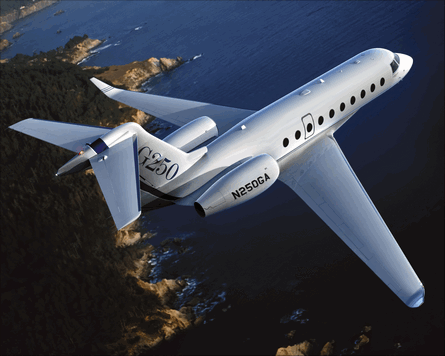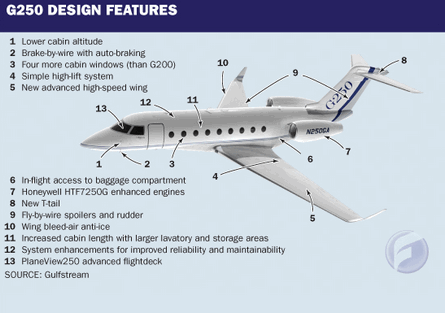If the “G” at the beginning of G250, a newest super mid-size business jet launched this week, did not stand for “Gulfstream”, one would be inclined to discount the validity of the forward-looking statements -- largest cabin, longest range and fastest speed -- made about an airplane won’t fly for the first time until the second half of 2009.
With Gulfstream in fact behind the new twin-jet, an evolution of the G200 super mid-size built for the company by Israeli Aircraft Industries (IAI), it’s a given that there is a mountain of engineering and assuredness behind the G250 claims however.
Internally launched in 2005, Gulfstream began the preliminary design with input from customers, who asked for improvements in cruise speed, takeoff distance, cabin size as well as the ability to access the baggage compartment in flight. Combined with internal competitive and operational studies, engineers then performed configuration studies and came up with an optimized design. Aerodynamic design for the metal wing and empennage was carried out by Gulfstream engineers while the IAI engineers completed the detailed design per Gulfstream requirements.
Low-speed wind tunnel testing at IAI and high-speed testing at the Duits-Nederlandse wind tunnel in the Netherlands using 1:7 and 1:14-scale models provided confidence in the reality of the design goals as related to the new wing, winglets, T-tail and wing-to-body fairings. IAI will build the fuselage, empennage and landing gear and will assemble the green aircraft in Israeli. After a ferry flight to Gulfstream’s Dallas, Texas facility, Gulfstream will complete the aircraft with one of three cabin layouts seating 8, 9 or 10 passengers.
 |
|---|
| © Gulfstream |
Powering the G250 is the Honeywell HTF7250G, a growth version of the HTF7007 turbofan on the super mid-size Bombardier Challenger 300. Normal takeoff take off thrust has been increased to 7,200lb (32kN), up from 6,826lb flat-rating for the HTF7007, with an automatic performance reserve of 7,445lb. Honeywell says it has built and run a version of the engine and is now building flight test engines for Gulfstream. Certification testing for the engine should begin later this year and finish in 2010.
Honeywell is also providing its 36-150 auxiliary power unit (APU) for the G250, a version that is 10dB quieter than the G200’s Allied Signal unit and can be started at altitudes up to 35,000ft, providing a third backup to the 28V 400 amp DC generators on each engines. Backing up the generators are two 38 amp-hour lead acid batteries and one 6 amp battery exclusively for flight critical instruments.
The resulting design promises to carry more than 1,814kg (4,000lb) of payload for nearly 4,630km (2,500nm) or 454kg for 6,297km. That means New York to Paris with four passengers at M0.82 or London to Dubai at the same speed. Competitors with similar cabin sizes would appear to pale in comparison, including the Hawker 4000, Challenger 300 and the G200, according to Gulfstream. The new Embraer Legacy 500, also a super mid-size, has projected payload versus range performance figures similar to the Challenger 300. Maximum cruise altitude is 45,000ft, equivalent to most of its competitors.
The G250 will carry that payload in the largest cabin in the class and reach its destination at a faster clip, largely owing to the new wing design that will be produced by Spirit Aerosystems. Wider and 1.5m longer than the G200’s wing for take off performance, the G250’s wing has a 31° sweep at the leading edge that helps yield a 23% improvement in aerodynamic efficiency at M0.80 and higher speeds. Overall the combination of more efficient engines and optimized wing will yield a 13% lower fuel burn at M0.80 cruise compared to the G200, says Gulfstream and will yield a maximum cruise speed (MMO) of M0.85 compared to M0.82 for the Challenger 300, M0.83 for the Legacy 500 and M0.84 for the Hawker 4000. Despite being optimized for the high end, the wing also produces a takeoff run 335m shorter than the G200 owing to Fowler flaps, one per side, that increase lift and decrease approach speeds by 20kt when deployed fully to 39°. No leading edge lift devices are required. Each flap is controlled by force-limited hydraulic actuators. Composite structures on the G250 include the vertical stabilizer, the radome, fairings and the outboard section of the horizontal stabilizer.
 |
|---|
At 26.5m3 (935ft3) volume, the G250’s cabin will be the largest in its class with the longest length (7.87m), 17-35% more floor area a 7,000ft cabin altitude at 45,000ft and the most voluminous baggage compartment, complete with in-flight access. Though the cabin structure itself is the same length as the G200, Gulfstream added four windows to increase natural light and removed the fuselage fuel tank behind the cabin to increase both the size of the cabin, the bathroom and the baggage area. The aircraft’s 6,622kg fuel load will by carried in the wings and centre wing box structure as well as in one forward belly and one aft-belly tank. Gulfstream says no crew action will be required to manage the fuel, which will be distributed automatically via gravity and an Intertechnique-built ejector pump system. Connectivity options will include Iridium satellite service for voice and data as well as high-speed options that Gulfstream continues to research. .
Acoustics is a key focus for the new cabin design, with Gulfstream committed to establishing a “step change” in cabin sound levels to ensure the G250 is the quietest among its competitors. The company is evaluating potential improvements with insulation, vibration isolators, window treatments and environmental control system ducting. Like Gulfstream’s new high end jet, the G650, the G250’s cabin is also being designed to prevent single failures from grounding an aircraft.
The G250’s cockpit will feature Rockwell Collins latest integrated avionics technologies as part of the Gulfstream PlaneView250 system. Included will be three 39cm (15.3in) displays, an optional Rockwell Collins HGS-6250 LCD head-up display and Gulfstream’s EVS II infrared camera system, enabling operators to qualify for category 1 instrument approaches down to 100ft (30.48m). Also included as an option is Gulfstream’s synthetic vision primary flight display (SV-PFD) using Rockwell Collins’ synthetic vision technology, which includes an onboard terrain database developed for its popular Pro Line Fusion package.
The aircraft will feature a largely traditional control system with the exception of dual fly-by-wire (FBW) rudder control and FBW multi-function spoilers. Roll control will use manually powered ailerons with geared tabs and assist from the spoilers while pitch control will use dual hydro-mechanical elevator controls with electronic hard-over protection. The G250 also features brake-by-wire with auto-braking, the only aircraft in its class to offer the feature, says Gulfstream. Moog, as the flight control system supplier for the aircraft, has an own bird test rig for the system, as does Gulfstream in its integration test facility in Savannah.
First flight for the G250 is slated for the second half of 2009, followed by a 1300h flight test program with three aircraft, leading to Federal Aviation Administration and European Aviation Safety Agency certification in 2011 and entry into service the same year.
 |
|---|
Source: Flight International
















